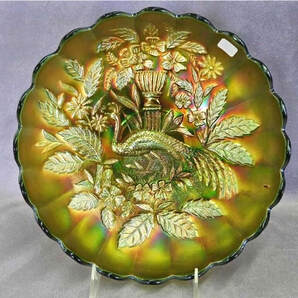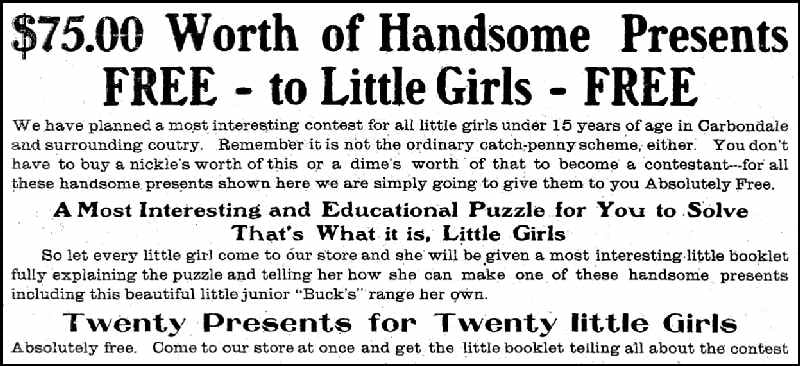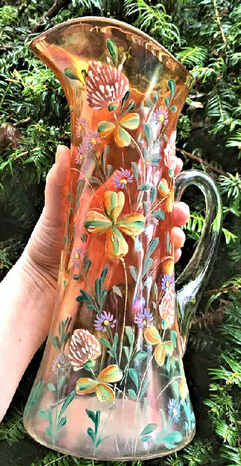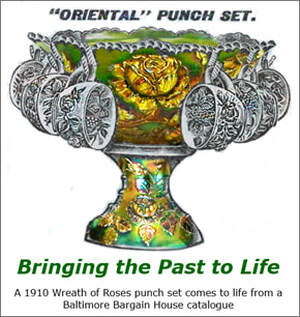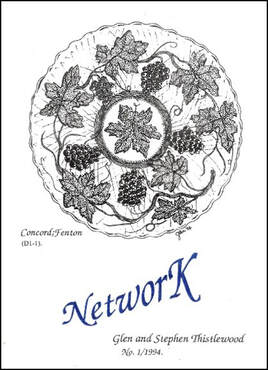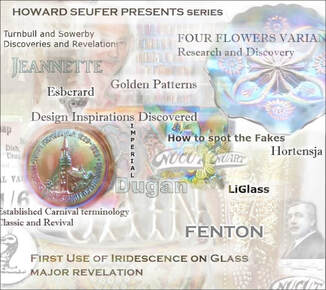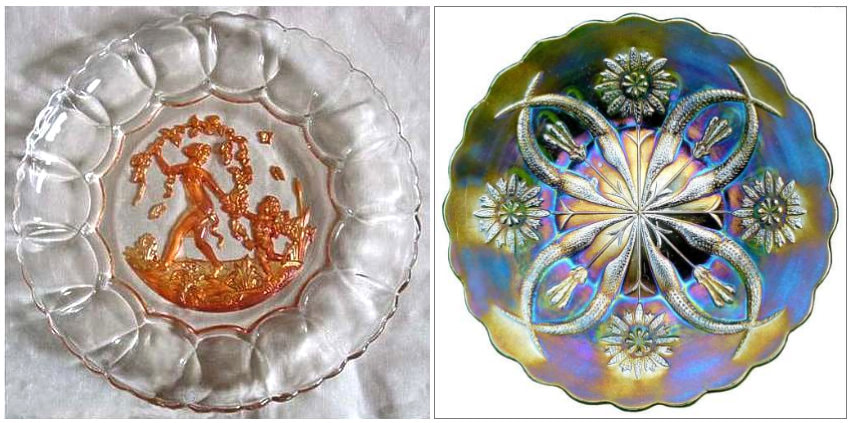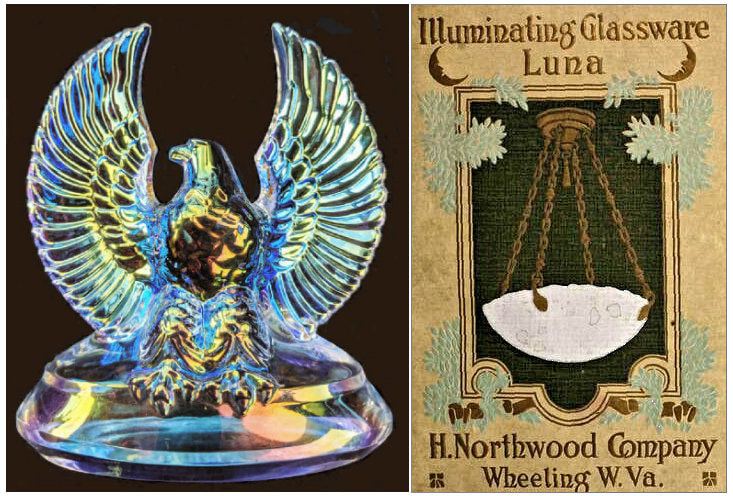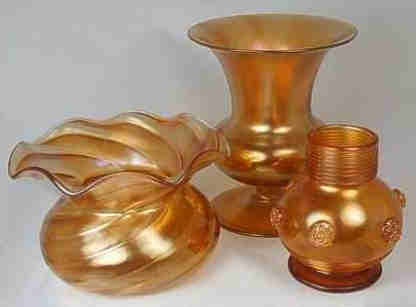NetworK ezine Issue 100. September 2023
Totally Devoted to Carnival Glass
|
We released our first ezine in June 2015 with the aim, as always, to share our passion for Carnival Glass with collectors all around the world. We mark this 100th edition with a phrase that epitomises what we do – we bring the past to life through our research, insights and discoveries. We hope you will enjoy this celebratory edition.
This hundredth issue of our ezine is lavish and extensive – filled with new revelations as always and in this special issue, there are reminiscences as well. We hope you’ll enjoy the journey with us, as we also include a look back to the early days of our collecting as well as our first NetworK journal back in 1994. Hold on though, ‘cos this isn’t going to be just a cosy journey! There will be some uncomfortable memories as well as the many pleasant ones. Peacock Power
If you had to select one motif or pattern that epitomises Carnival, it’s likely that you would chose the peacock. As a symbol, it’s been a favourite since the 8th century when it was popular in Japanese design, coming into its ascendency in the 1800s during the Art Nouveau and Aesthetic movements. Peacocks (in design) were all the rage when Carnival began, and coupled with scintillating iridescence, it was a “win-win”. Add a fancy urn and flowers and you clearly have a winning combination: the Peacock and Urn pattern, made by three of the main Carnival makers – Millersburg, Fenton and Northwood. Let’s see what secrets our investigation reveals … |
1910 Butler Bros ad for Fenton’s Carnival.
Colorised and brought to life. |
|
We were blown away by the sheer beauty of this illustration in the King’s 1912 catalogue, shown here on the immediate right, courtesy of the Glass Paper Fanatics. It is Northwood’s 5½” Peacock and Urn berry bowl. It was depicted in the catalogue alongside a Northwood Singing Birds tumbler, and both pieces could be obtained with the purchase of a 50 cent box of pain and fever tablets. It’s the first time we have seen an illustrated ad for Northwood’s Peacock and Urn pattern – and isn’t it absolutely magnificent? As well as the detailed art work, we also now have a specific date in which the item was in a mail order/jobber catalogue (implying that it had most likely been released during the previous year at least). |
Above left is an extract from Kings 1912 catalogue, courtesy Glass Paper Fanatics, showing a Northwood Peacock and Urn small bowl. On this right is the same item in green Carnival.
|
|
Millersburg and Fenton ads appeared for their versions of Peacock and Urn in Butler Brothers wholesale catalogues in 1911-1912. Above: a 1911 Butler Bros wholesale ad for Millersburg’s Carnival included a Peacock and Urn comport (top left) and bowl (centre left).
Right: Glen Thistlewood's detailed line drawing of Fenton's Peacock and Urn master bowl design |
What might the inspiration behind the Peacock and Urn pattern have been?
The Northwood, Millersburg and Fenton designs are all very similar in concept, with minor variations that keep collectors awake at night trying to identify them: changes to the bird's tiara, a bee or no bee, the flowers and the urn designs.
|
The illustration (right) shows a USA Fabric Patent Design from 1899 granted to W.T. Smith, Pennsylvania. It is so similar in many ways that it makes one wonder if something like this inspired the Peacock and Urn pattern? (As an aside, it also has elements that feature in the Peacock at the Fountain design by Northwood and Dugan.) Could all three makers have shared a common mould maker for Peacock and Urn? Many of the moulds used by the Classic Carnival makers were produced by the Hipkins Mould Shop and we know for certain that Hipkins had business links with Fenton and Millersburg. Also, George Hipkins was close to Harry Northwood, holding shares in the company and acting as pall bearer at Harry’s funeral. So, it seems fair to say that a common denominator between all three firms was Hipkins' mould company. And perhaps it is possible that Hipkins might have designed and made the Peacock and Urn moulds for all three (in much the same way that the German mould maker, Kutzscher made moulds with similar designs for many companies with slight alterations and differences for each one). Further Reading We have a great article about Hipkins here: Hipkins, master mould maker |
Above: Peacock and Urn pattern in green by three different makers. Left, Millersburg, centre, Fenton, and right, Northwood (courtesy Seeck Auctions).
Having trouble telling the different makers' versions of Peacock and Urn apart? This fully illustrated 6 page research work by Ronald L. Britt will show you: Birds of a Feather
|
Prizes for Little Girls
By today's standards, this ad on the right feels distinctly inappropriate. The ad, from October 1909, offering prizes “Free – to Little Girls” was clearly aimed at driving business to a store. The “little girls” would get an explanatory booklet when they visited the store, that told them how to enter the “educational puzzle” contest. The top prize was a “Little Buck’s Jr. Range” that “cooks and bakes just the same as the big Buck’s”. Other prizes in the competition for girls included a jewel box, a bracelet, a manicure set and (which is why we included it here) a “Hand Decorated Iridescent Ruby and Gold Lemonade Set” (prize no.10). |
|
What could this "Lemonade Set" have been?
Well, here it is, shown in the same ad! And what a splendid prize their No. 10 was! The illustration shows that it is a tankard water set in Fenton’s seldom-seen Windflower pattern.
The reference to ruby and gold probably indicates the marigold iridescence and possibly also there would have been a gold painted trim on the items too. Of very significant interest is the date of the ad - 1909. This shows that Fenton was producing decorated Carnival in their early years of production. In fact, such production was a continuation of their initial skills; Fenton had started off decorating blanks when they founded their company in 1905. Fenton’s own catalogue pages and Butler Bros. ads confirm production of their decorated water sets in 1911 and 1912, but this fascinating ad above shows they were also being produced several years earlier. Right: a marigold, decorated Fenton Windflower tankard pitcher.
|
Cherubs
Readers might recall our ground-breaking discovery regarding post-production iridising at LiGlass in our NetworK ezine #70. The Czech company used an advanced form of vacuum iridising on a variety of glass items, mainly from other Czech companies in the Sklo Union combine. The bowl shown on the right in the 1937 ad was made by the Czech glassmaker, Reich, and later reproduced by Libochovice in the late 1990s / early 2000.
Readers might recall our ground-breaking discovery regarding post-production iridising at LiGlass in our NetworK ezine #70. The Czech company used an advanced form of vacuum iridising on a variety of glass items, mainly from other Czech companies in the Sklo Union combine. The bowl shown on the right in the 1937 ad was made by the Czech glassmaker, Reich, and later reproduced by Libochovice in the late 1990s / early 2000.
|
It was those later reproductions that were iridised by LiGlass and indeed, one was featured on the front of the LiGlass brochure, as shown below. Right: a 1937 ad for Reich’s Cherub bowl in Australia's “Sydney Sun” newspaper. The item was not Carnival - it was "Green, Amber, Rose Pink, or Crystal." |
Further reading: We have the astonishing LiGlass Revelation here: The LiGlass Story
|
Network, Our Story: The Good, The Bad and The Ugly (apologies to Clint Eastwood et al.)
The Good Walk with us a short way down Memory Lane. |
We bought our first Carnival Glass in the mid-1980s - it was a green Northwood Sunflower bowl (left).
It ignited a passion in us, although we already had a marigold Carnival Curved Star bowl, that had been passed down to us from Glen’s grandmother, but we knew nothing about it. Our purchase of the Sunflower bowl changed everything – it inspired us, we wanted to discover more about its origins and history. It motivated us to learn about the social and economic circumstances at the time it was made, the patterns and design inspirations, and the lives of those who made Carnival a global phenomenon. |
In the late 1980s and early 1990s we visited libraries and archives, spending considerable time at the National Newspaper Library (then Colindale, London) and National Archives (Kew) as well as Shipley Art Gallery (Newcastle). Lots of dusty paper volumes that had to be “ordered” for viewing and then much paperwork to get photocopies. We travelled extensively across the USA, including spending time with the late Frank M. Fenton in his office, perusing and learning from Fenton archives. Later we made many study trips to Scandinavia, where we delved into Finnish and Swedish factory archives, museums, and antique markets. According to information on the Glass Museum’s website, the building was originally constructed in 1914 and converted in 1921 into a glassworks for Riihimaki. All the wonderful Carnival made by Riihimaki would have been produced here. The museum café is the old horse stables of the glassworks. Close by is Hyttikortteli, a housing area built in the 1910s for the glass workers. The beautiful wooden and brick houses are now privately owned homes, and some are small glass studios.
We also corresponded intensely with glass makers and glass museums all over the world, establishing and corroborating facts at source, including iconic correspondence with Mahavir Jain in India. Many thousands of miles and uncountable, enjoyable hours.
Our first printed NetworK Journal launches in 1994
Our research had produced a treasure trove that we felt compelled to share with the wider Carnival and glass community and by June 1994 we had amassed enough educational and research material to be able to begin producing our printed NetworK Journal. Below, on the right is the cover of our very first NetworK Journal - a ground-breaking publication, totally devoted to Carnival Glass and we snail-mailed it out to a worldwide audience of glass enthusiasts.
|
During the following, busy decade (we both had jobs and young children!) we continued the Journal. It paved the way for countless research articles including a special series for the “Glass Collectors Digest”. We also authored three, major, hardback Schiffer books on Carnival, created and grew our website, and initiated our innovative series of eBooks. Of course, much of this was before the days of easy access to archives and old catalogues on the internet. Who remembers using the incredibly slow and intermittent dial-up access to the internet through a plug-in telephone modem? Through our original drawings and clear photos, backed up by intensive research, we established new ways of looking at, and learning about, Carnival. We explored motifs such as peacocks, flowers, geometrics and more – we delved into the history and design inspirations behind the glass (from all eras) – and we broke new ground, uncovering makers, patterns and more, often helped by fellow researchers and collectors around the world. There was also a less-than-serious side to our work! |
|
Our Network ezine launches in 2015
In June 2015, a set of unpleasant circumstances motivated and incentivized us to fire up NetworK again, and our ezine was re-born, like a phoenix. Now, the internet offered instant, worldwide communication: we could share our research, invite feedback and comment and learn collectively. In NetworK we look at Carnival Glass through the eyes of the people who made it, marketed it, advertised and sold it, and crucially, the public who bought it and made it so incredibly popular. Right: a banner illustration created for our NetworK #17, in October 2016. It featured an ad from a 1911 Lee Manufacturing catalogue showing a Northwood Strawberry bowl. |
For this, our 100th issue, we browsed through our Back Issues (published on our website) and it has been quite a journey!
|
Above: a collage of NetworK Highlights.
|
Our purpose and drive is best described as Bringing the Past to Life, through the use of archive material, catalogues, past newspapers and journals, old ads, wholesaler (“jobber”) ephemera, and original factory records ... all illustrated with the most wonderful pictures of Carnival! Our aim is very clear: to inspire others with the amazing history and beauty of Carnival Glass, made all around the world, from its beginnings right up to the Revival era and today. Despite our comments which you will see later in "the Bad and the Ugly", we freely share what we have discovered through our research and the regular exchange of information with other researchers, scholars, and collectors. We aim to publish insights, revelations, our discoveries and our "scoops" – usually adding further detailed information in extended features on our website. NetworK is here to share our cutting-edge research, and also to update any erroneous facts or misplaced “accepted wisdom”. We’ll share just a few highlights with you below. Our Back Issues are linked below. |
Discoveries of previously unknown patterns, glassworks and more, including Turnbull, LiGlass, the Golden Patterns, Melon Ribs, Sowerby and of course, the Four Flowers Variant. Insights into U.S. Glass Co., Dugan and Diamond history and revelations into the life and the "Triumph and Tragedy" of Harry Northwood. We have discovered, traced and established many design inspirations and original pattern names.
|
Above, left - one of Zabkowice's brilliant "Golden Patterns" - a Butterfly Catcher large plate, and on its right is a Four Flowers Variant 9" plate, most likely made by Brockwitz.
|
Above left - a wonderful Eagle Paperweight, made by Stolzle and vacuum iridised by LiGlass (Photo and identification courtesy Angela Thistlewood). On its right, Luna lighting on the cover of Northwood’s 1913 catalogue - part of Harry's "big mistake".
|
How to recognise Fakes has also been a speciality of ours, and a "mission" that we know has helped so many collectors.
How to recognise Fakes has also been a speciality of ours, and a "mission" that we know has helped so many collectors.
|
Another of our missions has been to fully recognise and record the technical and artistic skills of all the amazing people who were key participants in the Carnival glassmaking factories all around the world, from Classic Carnival times, right through the the modern day. We have been honoured to be able to share excellent and truly informative work by (the late) Howard Seufer - an expert in glassmaking techniques - who was always willing to share his knowledge with the Carnival glass world. We were also privileged to present some of Howard’s historic videos of (the late) Frank M Fenton and the Fenton factory, thanks to Marty Seufer, in our special feature, Howard Seufer Presents. |
We created and established Carnival Glass Terminology. In our Network ezine #74 (June-July 2021) we introduced the term “Carnival Revival” to refer to what had previously been called “Contemporary Carnival”. Now, “Revival” era (for Carnival 1960s to date) is a generally accepted term. This echoes the introduction of our innovative term “Classic Carnival” back in 1997 which is in general usage.
|
Iridescence on Glass traced back to 1856. Iridescence is the heart of Carnival Glass, but what about its origins? Leo Valentin Pantocsek (pronounced Panto-check) is a name to remember. He was a Polish scientist who “invented" the use of iridescence on glass in around 1856. Our major ground-breaking, original feature on the beginnings of Carnival is not to be missed. We published this on our website in October 2017, – our “take” on it, in the context of Carnival, has been “reused” by others. Here is the link: The Use of Iridescence on Glass Shown on the left are three superb golden iridescent vases probably made in Stourbridge, England in the late 1800s, early 1900s. They are, left to right: “Iris” vase by Thomas Webb & Sons, c. 1878 (WEBB’S IRIS GLASS is acid etched on the base); golden iridescent pedestal footed vase, possibly Stevens & Williams; tiny, golden iridescent vase with prunts and moulded, threaded top, maker unknown. |
|
Not forgetting Facebook of course.
Linked to our Carnival NetworK ezine is our Carnival NetworK Facebook group. Formed in September/October 2016 as an on-line, round-the-clock partner to the ezine, our Facebook group now has almost 15,000 members from all around the world. The Bad and the Ugly “If you are going through hell, keep on going. Never, never, never give up.” Winston Churchill. Our walk down Memory Lane also brought back some difficult recollections. The impetuses behind our original 1994 NetworK journal as well as our 2015 NetworK re-launch as an ezine, were both centred on unpleasant circumstances. There’s no doubt that we ruffled some feathers along the way! Back in 1994, some people were not happy about our NetworK venture and even suggested that we should have asked their permission before we created our own educational journal. It seemed to them that we were challenging the natural order of things, and we were lambasted with very unpleasant comments in the weeks immediately after we sent out our first edition. |
Glen's original logo,
designed in 1994 for NetworK. |
But we’re pleased to say that very many more people supported our endeavour, and we increased our NetworK circulation very rapidly, with a growing number of copies being shipped internationally to many countries around the world. Yes! We were up and running!
We won’t go into the grubby details, but it’s fair to say that the obstacles and challenges we have faced over the years are possibly not what you might expect or even imagine – we certainly didn’t. We were even subjected to an especially unpleasant episode of coercion and intimidation. We’ll confess that there were times when we almost felt like giving up and surrendering.
Were the struggles and heartache really worth it? We knew that giving up was what our various tormentors wanted us to do, and so we didn’t. We carried on, working harder, doing more and going from strength to strength. Our research and writing about Carnival, coupled with our search for factual accuracy, are all so very important to us. Each time we have felt attacked and bullied because of our work in Carnival our response has been to turn the negative situation into a positive one. The feeling of being under attack had incentivized us and ultimately had been instrumental in helping us follow our quest and achieve our vision.
Are we “mavericks”? Possibly. Being independent and sometimes unorthodox allows us a freedom to research and publish without hindrance. Thankfully, over the years, our detractors have dwindled to a tiny (albeit at times, annoying) minority, as the original misinformation about us has proved to be entirely fabricated.
However, one problem that is still around, and sadly growing is plagiarism and the copying of our research. Of course, we have been doing this work for well over thirty years, and so, it’s not surprising that much of what we have written in the past has since become embedded in the Carnival Glass world.
However, plagiarism has been a problem since the first of our hard-back books was published in 1997, when some of our Intellectual Property was stolen and published elsewhere without permission or acknowledgment (it was happily resolved legally and amicably). But what is not right is when we see our fresh research or discoveries being “revealed” by others, passing off our work as their own, without any recognition or reference to our work as the original factual source. Another sneaky method that we see being used, is the plagiarising of ideas and articles. They then write it in their own words, add a few extra flourishes and attempt to pass it off as all their own work. You have to chuckle at the irony when our detractors use our work to support their purposes.
We put a lot of time, effort and experience into our research – delving into archives, chasing up leads, sources, old records and catalogues. We freely share the results of our efforts in our publications and on our website, but we do ask that our Copyright is respected and acknowledged - just as we always aim to acknowledge our sources. It’s the scholarly, ethical way, plus it provides accuracy, context and further information.
Enough said! It’s history – unless we decide to write a “block-buster” Memoire (only joking!).
You can read and see more about our story, where we show a variety of interesting ephemera from our early days. Our “look-behind-the-scenes” feature was written in 2019 for our 25th anniversary of NetworK. We also include some of the original story-boards that we made for our Carnival videos back in 1996 - on VHS and NTSC cassettes, who remembers them? Here is the link: Carnival Glass Network – the Story Behind the Stories
|
We Couldn’t Do It Without You.
We’ll raise a (virtual) glass to all our readers and thank you for being with us on our NetworK journey. From the very beginning of our research and writing we have been supported and helped by many other researchers and collectors. We are indebted to each and every one of you. We are also deeply grateful to everyone who reads our work and to those who contact us with messages of support – it’s impossible to put into words just how much they mean to us. We’d like to thank all of you by name, but the list would be too long for this context, as we have had so much help and input from so many wonderful collectors. However, we want to acknowledge some people and organisations who have been fundamental to our work. Special thanks to (in alphabetical order): Jon D. Bartell and The Glass Paper Fanatics, Claudio Deveikis, Joan Doty, The late Frank M. Fenton, the Fenton Family and Fenton Art Glass Company, Siegmar Geiselberger, John Hodgson, Dieter Neumann, The late Howard Seufer, Marty Seufer, The late Bob Smith. |
|
Here's to the next 100 NetworK Issues
We end this 100th issue on an uplifting and happy note, and once again let’s "bring the past to life". The Carnival we show above is in the pattern we named “Provence” back in the early 1990s, after we found the water pitcher in the Provence region, when on a family holiday in the south of France. The "tumbler" is not shown to scale (LOL!); in fact it's only about 3¼ inches/8 cm in height, a size that Inwald called a "Madeira". We were at a little flea-market when we spotted the pitcher – you can imagine how excited we were. We were not aware of the pattern being reported before and so the name we gave it - “Provence” - went into print in our published books. In 2005, thanks to Siegmar Geiselberger and Dieter Neumann, catalogues were shared that showed it is an Inwald pattern named “Rivoli”. |
So now we give it two names – “Provence” and Original Maker’s Name (OMN) “Rivoli”. Taking us right up to today and spanning the years, our beautiful Madeira (or port) glass is a more recent discovery. Perfect for a drink to the next 100 Issues!
Privacy and the use of your information: we only use your name and email address to send you your Carnival Glass NetworK ezine. We will not share your name or email address with anyone else, or use it for any other purpose. You can change your mind about receiving your NetworK ezine at any time by clicking the unsubscribe link at the foot of every issue, or by emailing us at [email protected]
Join us on Facebook
We invite you and your friends to join us all on NetworK's fast growing and very active Facebook Group (link is below), and if you have missed any of the previous issues of NetworK and NetworK Specials, they are all here: Back Issues.
We invite you and your friends to join us all on NetworK's fast growing and very active Facebook Group (link is below), and if you have missed any of the previous issues of NetworK and NetworK Specials, they are all here: Back Issues.










